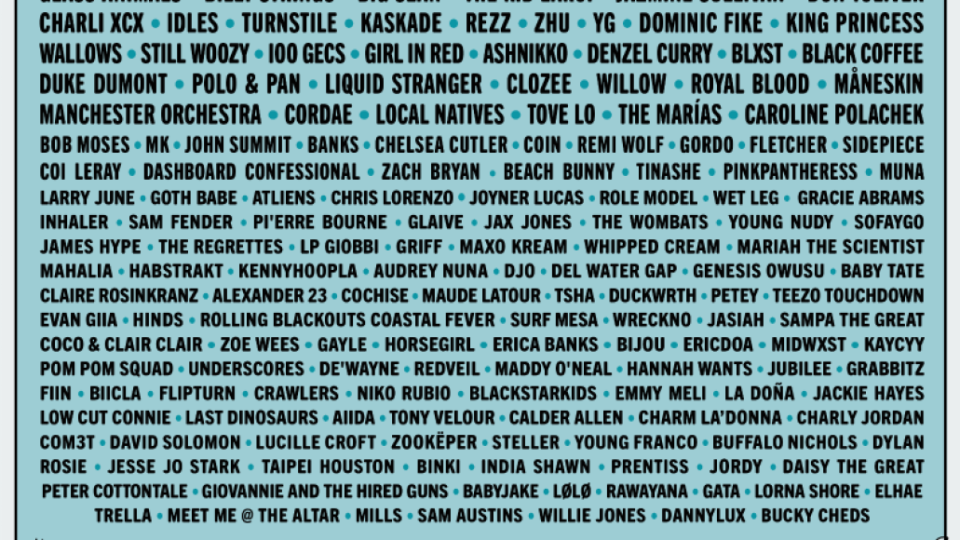A Definitive Ranking of Every Lollapalooza Lineup from Worst to Best
- Oops!Something went wrong.Please try again later.
The post A Definitive Ranking of Every Lollapalooza Lineup from Worst to Best appeared first on Consequence.
Editor’s Note: This ranking of every Lollapalooza lineup was originally published in 2019, and we’ll keep updating it as long as the biggest festival in Chicago keeps rocking. Can you guess where this year’s poster falls?
It’s hard to believe that, in 1991, Perry Farrell created the festival as a showcase for Jane’s Addiction’s last hurrah. Of course, many things have changed since its initial heyday in the ’90s. In the US, Lolla has grown and evolved drastically from its touring festival roots, having survived a hibernation from 1997 until 2003, in addition to its canceled 2004 installment, and the virtual presentation in 2020 due to the ongoing COVID-19 pandemic (because it was online, that fest is outside the scope of this exercise).
Since then, Lollapalooza has settled down in the Windy City, gradually expanding from two to three to four days. (Though, one could argue the fest’s touring spirit lives on through its international counterparts, which have sprung up in Chile, Brazil, Argentina, Germany, and Sweden.) Throughout its history, some of the most iconic acts in music have performed at the festival, from Paul McCartney to Kanye West to Arcade Fire, in addition to up-and-coming talent that have since become future can’t-miss attractions everywhere.
Ahead of this year’s festivities, we’ve dug back through the archives to take a close look at every lineup in the festival’s storied history (including the canceled 2004 festival, but excluding international editions) and ranked them from worst to best. In devising our list, we took into account artists’ statures the years they performed, their historical relevance looking back now, as well as missed opportunities and what could’ve been better.
So join us on a trip through the past of this iconic festival (and its sweet posters), and let us know which lineups are your favorite.
NR. 2004 (Canceled)
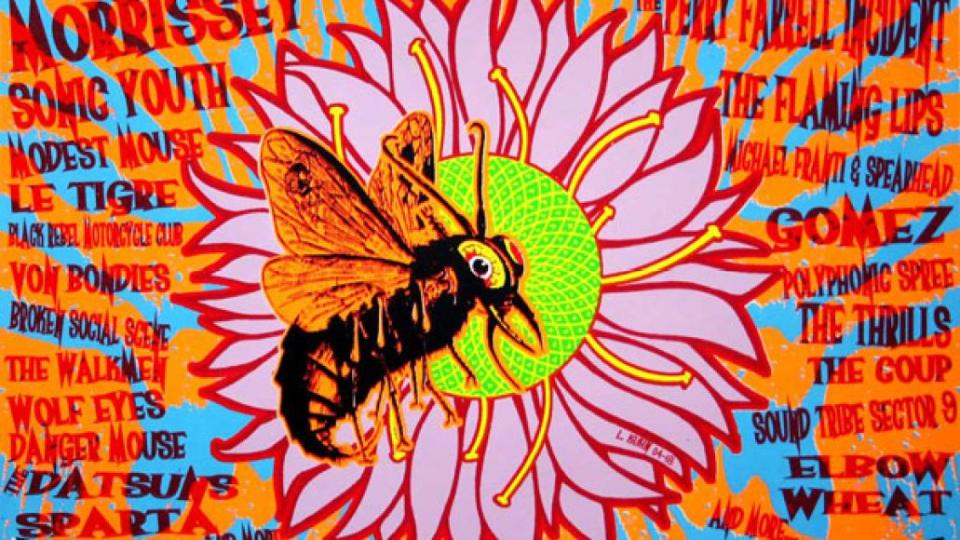
The Good: Considering 2004’s festival was cancelled, the good is more about what could have been. Acts who were slated to perform included Morrissey (who was probably angered the festival had been cancelled before he had the chance to bail), The Flaming Lips, The Killers, Broken Social Scene, and Modest Mouse, to name just a few. It also would have seen the return of Lolla veterans Sonic Youth and Wilco.
The Bad: Obviously, the bad news here is that due to poor ticket sales, the festival was cancelled. Lollapalooza ’04 was to stop at 16 locations, with the ambitious goal of two dates of different music at each stop. Even worse news is that had the festival gone as planned, the (then) newly reunited Pixies would have headlined the Chicago stop.
Interesting Fact: The failure of 2004 did bring some good in the sense that it landed Lollapalooza a permanent home here in Chicago. I’d say that’s a pretty solid silver lining.
–Lyndsey Havens
26. 2003
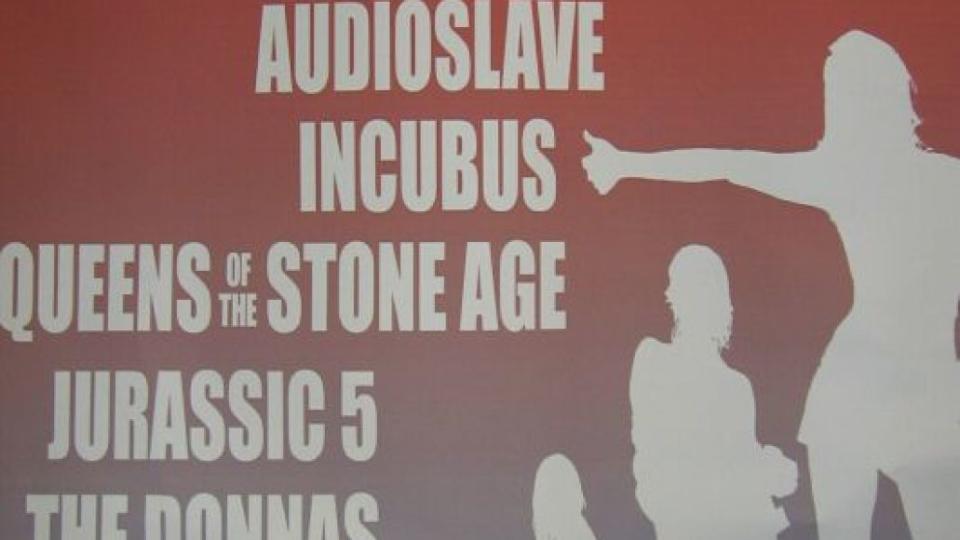
The Good: After a six-year hiatus, Perry Farrell decided to resurrect Lollapalooza and hit the road once again for a 30-date tour. It was an ambitious goal, especially following the massive amount of criticism he’d weathered over the festival’s previous few years. Unfortunately, some of the booking choices for the return weren’t exactly well thought out. Jane’s Addiction at the top of the poster is a definite plus, as is Queens of the Stone Age, who were then riding high on the back of Songs for the Deaf, and Maynard James Keenan’s side project A Perfect Circle, but after that, the pickings are disappointing at best and stomach-churning at worst.
The Bad: Where to even begin? Soundgarden is a great band. Rage Against the Machine is also a great band. Audioslave, the amalgamation of the two with Chris Cornell on vocals and Tom Morello on guitar, is not a great band. Other draws, like Rooney, 30 Seconds to Mars, Incubus, or The Mooney Suzuki, aren’t that much better. Also, the sheer lack of rap acts here is staggering at a moment when rap was clearly overtaking guitar-based rock as the main cultural mover in the musical space.
Interesting Fact: The first iteration of Lolla after a six-year hiatus and the last version of the festival to tour the country. Marred by slow tickets sales, many dates of the tour that were originally announced later had to be cancelled.
–Corbin Reiff
25. 1997
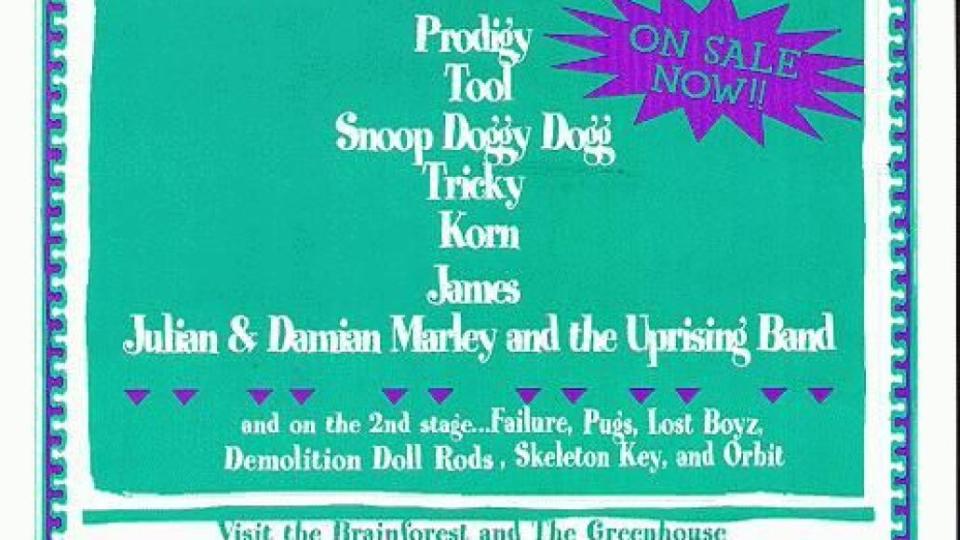
The Good: After the very rock-centric main stage lineup of the previous year’s event, the organizers strove to get back to their eclectic roots with the 1997 installment. And for the most part, they succeeded in a fairly interesting way. They rotated the headlining spot among four acts — Orbital, The Prodigy, The Orb, and Devo — trying to make each night unique. What’s more, they dipped their toes again into the rising tide of metal and hard rock with main stage performances by Tool, at this point showing their full prog-heavy mettle with their second full-length, Aenima, and, until they pulled out of the fest for health concerns, the rubbery Goth-leanings of Korn. True to form, they paid heed as well to hip-hop with the inclusion of Snoop Doggy Dogg, who was still riding (ahem) high on the success of his second solo album, The Doggfather. In and around those big names were festival-friendly acts like G. Love & Special Sauce, Bob Marley’s sons Stephen and Julian, and Britpop act James who, by then, still hadn’t lived down the surprise US success of their song “Laid”.
The Bad: Again, the main stage of Lollapalooza was disappointingly dude-heavy. And with alternative rock finding less and less commercial love from US audiences, the festival saw a marked drop in attendance. That played a huge role in the fact that the festival couldn’t find a suitable headliner for its planned ’98 edition, forcing them to shut down operations until 2003.
Interesting Fact: Failure is the only band to be asked to pull double-duty by the festival. The popular shoegaze rock band were on tap to headline the side stage, but were brought to the main stage to fill the spot left vacant by Korn for the back half of the tour.
–Robert Ham
24. 2005
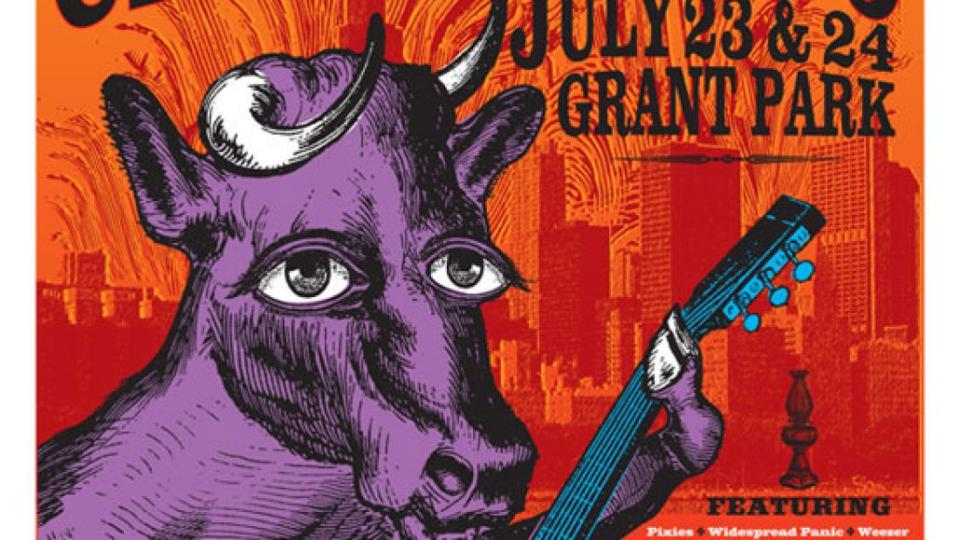
The Good: After 2004’s canceled edition, Lollapalooza recouped one of its biggest originally slated artists, The Killers. Brandon Flowers and co. solidified their status as legitimate superstars on their debut, Hot Fuss, which would go platinum. The festival also made prescient picks with The Black Keys (who had yet to have a single break into the US Billboard charts) and Arcade Fire (who were riding high after the critical acclaim of Funeral, released the previous fall). Outside of The Killers, Dashboard Confessional were one of the most commercially successful outfits on the bill, with A Mark, a Mission, a Brand, a Scar peaking at No. 2 on Billboard’s charts and hit single “Vindicated” under their belts. Kaiser Chiefs’ 2005 debut was a much bigger smash in the UK, but earned the British rockers a spot as one of the most buzzworthy up-and-coming acts. Other artists who called the Windy City home — including OK Go and Liz Phair — got the chance to dazzle the hometown crowd. Although not as popular as in the ‘80s, Billy Idol made a comeback with his first album in over a decade. Digable Planets also reunited 10 years after their breakup, with a new compilation record in tow. Alongside Saul Williams, their sets represented a burgeoning opportunity for hip-hop to gain a greater foothold at the festival.
The Bad: From the failed previous year, Lolla was unable to retain a lot of its other top-tier talent, including Morrissey, PJ Harvey, and Sonic Youth. And consequently, this year had a less-than-stellar headlining slate. Despite their solid live reputation, top-billed Pixies hadn’t released new music in well over a decade. And the lineup still skewed very heavily toward alternative rock. The solid rock acts on the bill (Dinosaur Jr., Weezer, Primus) would’ve been far better draws in their respective ’90s heydays.
Interesting Fact: After existing as a touring festival in its earlier days, Lollapalooza settled down at Chicago’s Grant Park for the first time. The event only took place in the Windy City for one weekend.
–Killian Young
23. 2021
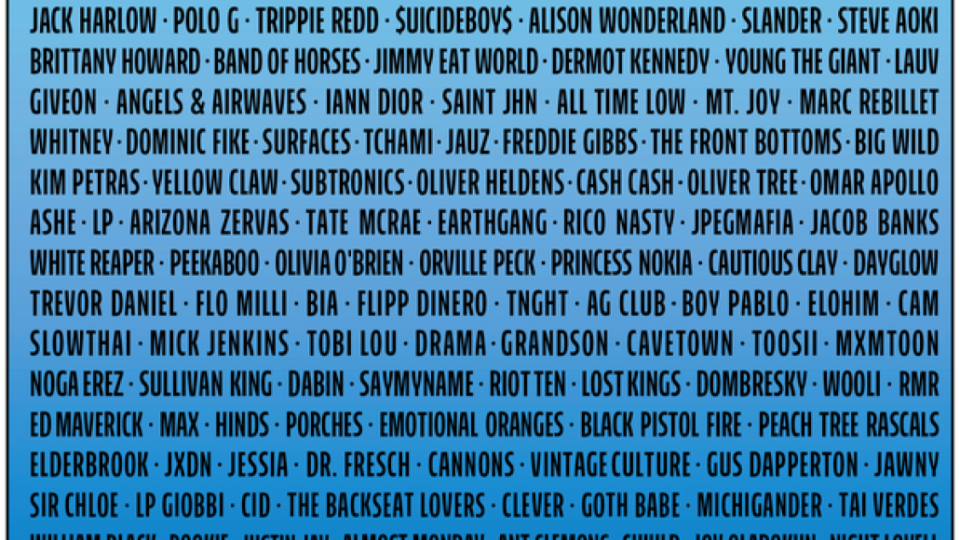
The Good: Even in complicated circumstances (post-vaccine, ongoing pandemic), Lollapalooza always manages to nab some decent bookings. The headliners weren’t particularly unique for a festival in 2021, but Foo Fighters, Miley Cyrus, and Tyler, the Creator certainly brought their A-game and treated fans to some rowdy sing-a-longs across Grant Park. In the undercard, there were some impressive and notable artists who are always welcome at festivals — Chicago native Mick Jenkins, emo stalwarts Jimmy Eat World, queer cowboy Orville Peck, Hudson Mohawke and Lunice’s project TNGHT, and the soon-to-break-up BROCKHAMPTON were all standout bookings. In fact, 2021 was Lollapalooza’s most hip-hop-centric year; a festival with Tyler, Megan Thee Stallion, Playboi Carti, Young Thug, Roddy Ricch, Earthgang, Flo Milli, JPEGMAFIA, Freddie Gibbs, Princess Nokia, and Rico Nasty, amidst dozens of other big rappers, is pretty noteworthy.
The Bad: Overall, 2021 was a pretty thin year for Lollapalooza. There are large swaths of viral artists that live in “bland” territory, like Surfaces, Jack Harlow, Oliver Tree, Tate McRae, Trevor Daniel, and Gus Dapperton. There’s plenty of good hip-hop, and plenty of hip-hop that certainly won’t stand the test of time. The EDM choices are also particularly uninspiring; Illenium, Alison Wonderland, and Slander are the brightest of the bunch, and the rest — with the slight exception of Brazilian DJs Vintage Culture, who’ve risen greatly since 2021 — aren’t very unique or in high demand. Then there’s the nostalgia bookings: Jimmy Eat World is great, but Journey? And Limp Bizkit? Weird, but okay! In fact, 2021 was generally not the year for rock bands, or for rock-adjacent artists (the exception there being the prolific rise of emo rap — Iann Dior, Trippie Redd, and $uicideboy$ are all deeply influenced by rock and pop-punk).
Interesting Fact: If it wasn’t obvious by the year, the bookings, and its placement on this list, 2021 was the first edition of Lollapalooza — and major festivals as a whole — to be held during the COVID-19 pandemic.
— Paolo Ragusa
22. 2017

The Good: Lorde, Spoon, and Cloud Nothings returned to Lollapalooza with some of their strongest efforts to date, though none of them were particularly unique to the festival. (It also doesn’t help that Lorde got rained out a couple songs in.) Chance the Rapper was a blast to see at home during a set that drew some of the festival’s biggest-ever crowds. Then there’s Arcade Fire, who were the only legitimate edge to the lineup, and who were subsequently dragged around in the press for delivering arguably their weakest album by about 10 miles (see: Everything Now). In sum, there was a lot of good in 2017’s lineup, but nothing particularly exceptional, at least not to the festival, and that’s a problem.
The Bad: By 2017, it was obvious that the four-day expansion had proven to be quite a challenge for C3. Spreading talent over that long of a stretch produced day-to-day schedules with far too many gaps, questionable placements, and overall stagnation. What’s worse, the extra day also led to some miserable bookings such as the embarrassing Tom DeLonge-less Blink-182 and the unimaginative repeat headliners like Muse or The Killers. Let’s not forget the gluttonous inclusion of festival leftovers, from Wiz Khalifa to Capital Cities to George Ezra to The Pretty Reckless to Vance Jyy… shall we go on? For every exciting act, 2017 delivered two more contract acts that made deals to appear everywhere. Not very inspiring, to say the least.
Interesting Fact: Prior to his health problems at the end of 2016, Kanye West was in queue to headline the festival, industry sources told Consequence of Sound. The same goes for The Weeknd. At least one of them would have upgraded this lineup considerably.
–Michael Roffman
21. 2011

The Good: This year’s lineup saw the midday and later afternoon sets brimming with bands who were reaping the benefits of a successful debut album: Local Natives, Foster the People, The Naked and Famous, and Grouplove among others. The lineup was further strengthened by more established indie rockers Cage the Elephant, Portugal. the Man, Cold War Kids, and Young the Giant. And as the sun set, there were still several suitable sets left to catch from the likes of veteran acts Bright Eyes, Atmosphere, Ween, Arctic Monkeys, and My Morning Jacket. However, considering the festival was celebrating its 20th anniversary, some might say the headliners fell a bit short of expectations. While some were riding the waves of recent records — Coldplay with Mylo Xyloto and Foo Fighters with Wasting Light — Muse had yet to release a new album since 2009, and Eminem’s last effort came the previous summer, causing for a setlist heavy on older hits.
The Bad: Considering most of the morning and early afternoon sets were filled with festival first-timers (acts who had just released a debut, as previously stated), the days were naturally off to a slower start. Releasing an acclaimed album and developing a commanding stage presence for thousands of people doesn’t exactly happen over night, but most bands made it work. A more serious dilemma from 2011 was that not only had Perry’s stage doubled in size to accommodate for more than 15,000 fans, but it was also relocated to the south end of the park, right near the main stage — a little too close for comfort, as many headliners have had to find out (see: Paul McCartney, 2015).
Interesting Fact: 2011 marked Lollapalooza’s debut outside of the US with Santiago, Chile, as its first international location.
–Lyndsey Havens
20. 2019
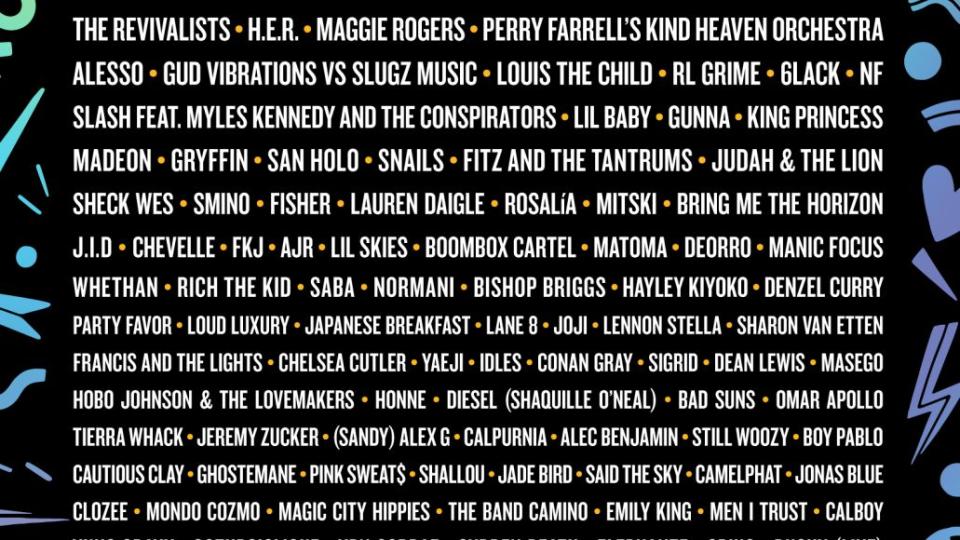
The Good: Let it never be said that Lollapalooza doesn’t listen. In response to criticism of last year’s dudefest, Lollapalooza went out and booked the women behind some of last year’s best records; in 2019, you can catch sets by artists including country crooner Kacey Musgraves, flamenco crossover star Rosalía, genre-bending funk-bot Janelle Monáe, and Ariana Grande, who becomes just the seventh female artist to headline the festival. That newfound commitment continues into the smaller text, where you’ll also find everyone from Mitski to Sharon Van Etten to Japanese Breakfast. Other highlights include Childish Gambino (who enters the Chicago leg of his “This is America” victory lap), Lil Wayne (somehow just making his Lolla debut), and rock absurdists Tenacious D. Oh, and Shaq is gonna be here. That’s neat.
The Bad: While Ariana Grande and Childish Gambino are creating some well-earned heat for this year’s festival, the rest of the headliners set off some alarms. The Strokes haven’t released a new record since 2013, Tame Impala still hasn’t released a new record since they last appeared in 2015 (and they also just headlined Pitchfork 2018), and the inclusion of both the Chainsmokers and Twenty One Pilots sounds like the beginning of a recurring nightmare set in a vape shop. Also, perhaps this is the emerging curmudgeon in me, but this year’s slate feels like the lightest on indie rock that we’ve ever seen; when your standard bearers are late-era Death Cab for Cutie, you’re officially a genre in crisis.
Interesting Fact: Speaking of Death Cab for Cutie, they’re the only artists on this year’s lineup that also played Lollapalooza’s first Grant Park edition in 2005.
–Tyler Clark
19. 2014
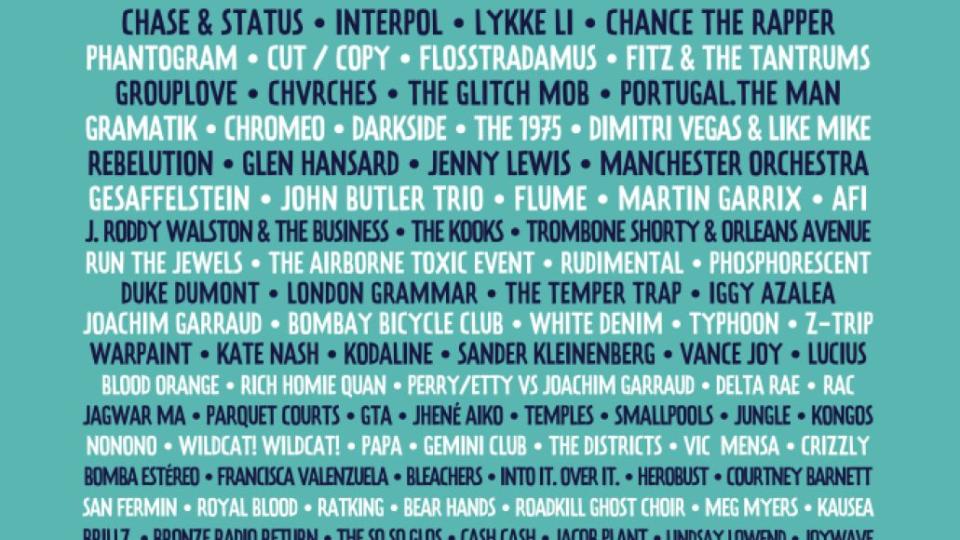
The Good: Even though he’s the best-selling artist in rap history, late-career Eminem doesn’t hit the road all that often. However, when he does, he packs football and baseball stadiums with ease, and the tickets go fast. Grabbing Marshall Mathers to headline one day and having a recently reformed OutKast hold down another while Nas, Run the Jewels, Chance the Rapper, and Childish Gambino filled out some of the down-card slots marked the Chicago festival as maybe the premier event to take in live rap music in 2014. That wasn’t all of course; there was also a major abundance of top-tier rock from the likes of Interpol, Spoon, Arctic Monkeys, Parquet Courts, and a then up-and-coming Courtney Barnett. And for the pop set, there was peak-popularity Lorde, The 1975, and Broken Bells. They even brought in some New Orleans Jazz courtesy of Trombone Shorty. In 2014, organizers really got things right by offering a little something for everyone. Oh, and Rihanna joining Em to belt out “Love the Way You Lie” was pretty amazing too.
The Bad: It kind of depends on how you feel about EDM. If you’re a fan, there’s not too much to complain about; if you aren’t, then the inclusion of Skrillex, Calvin Harris, and Zedd near top of the bill could be taken as a major strike against. Combine that with a downturn Kings of Leon as a headliner and the admittance of Iggy Azaela into the confines of Grant Park, and there’s plenty to grumble about.
Interesting Fact: Hundreds of thousands of people made it to the festival in 2014, but the most notable among them was none other than First Daughter Malia Obama who made it out to Lolla’s last day to take in Chance the Rapper’s set. She might have gone unnoticed too if not for the Secret Service detail who monitored her every interaction.
–Corbin Reiff
18. 2018

The Good: With even minimal hindsight, Lollapalooza’s 2018 lineup looks better now than it did at the time (and it looked pretty decent then). While most of the immediate coverage focused on Vampire Weekend’s return to the American festival scene, Post Malone’s eyebrow-raising attendance figures, and the full pop triumph of Bruno Mars, those big names now seem less important than the smaller ones below them. Lollapalooza wound up capturing sets by some of the most buzzed-about artists of the last couple of years right before they went supernova. Squint at the small text and you’ll find names like Billie Eilish (No. 1, Billboard 200), Lizzo (No. 1, Rolling Stone 200), Lewis Capaldi (No. 1, UK Albums Chart), and Greta Van Fleet (No. 3, Billboard 200). Throw in some more legit hip-hop acts (Tyler, the Creator, Brockhampton, LL Cool J) and a few names from the festival’s indie-pop days (Franz Ferdinand, Lykke Li, CHVRCHES, St. Vincent), and the schedules just wrote themselves.
The Bad: The surprising depth of the small-text acts came balanced by the relative weakness of some of the headliners. Outside of Vampire Weekend and first-timer headliner Travis Scott, the festival’s top lines underwhelmed; The Weeknd, Jack White, and Arctic Monkeys were all saddled with the relatively weak material of their uneven latest albums, and the National’s sad-eyed throwback indie rock left them stuck as the sacrificial lamb opposite Bruno Mars’ pop spectacle. The festival also suffered from a dearth of female artists (in terms of poster placement, you have to go to the fourth line before you hit St. Vincent) and more than a few bookings (chiefly the not-ready-for-primetime Lil Pump and the mind-numbingly earnest Logic) that placed ticket sales far above taste.
Interesting Fact: After their headlining appearance at Lollapalooza, Vampire Weekend played an aftershow at the Metro, where Ezra Koenig debuted five songs from 2019’s Father of the Bride by playing them off of his phone.
–Tyler Clark
17. 2022
The Good: For the suits behind Lollapalooza, 2022 was a hectic year. Plagued with some of their biggest names dropping out as the festival drew closer, Lolla was put in a position to make some hard decisions — and make them quickly. To their credit, they largely made the correct decisions. For the dads who’ve been there since ’91, replacing Jane’s Addiction with Perry Farrell’s other iconic alt-rock act Porno for Pyros, which had been resurrected after 26 years in the grave just a few weeks earlier, was more than a suitable consolation prize. And for the youngins, swapping Doja Cat (who dropped out after undergoing tonsil surgery) with BTS’ J-Hope proved to be a historic move. Not only did the decision make the K-pop star the first South Korean to headline the main stage, but the strength of his performance seemed to cement the genre’s destiny to slowly take over American music festivals. Add to all of this a particularly strong batch of artists when it comes to rock music (Metallica, Green Day, IDLES, Turnstile, etc.), and you’ve got a damn decent year for the Chicago fest.
The Bad: As recounted by our reviewer, several artists (even those with undoubtedly fantastic recorded work) seemed out of place or inexperienced on stage. While their sets weren’t disastrous by any means, artists like PinkPantheress, Wet Leg, and Maxo Kream came across as disappointingly underprepared to command the Lollapalooza crowd. But, hey, nothing that a little more touring can’t fix.
Interesting Fact: In addition to problems with stolen phone scams, 2022 was also the year that a Lolla security guard faked a mass shooting to get out of a shift. Yeah, really.
— Jonah Krueger
16. 2016
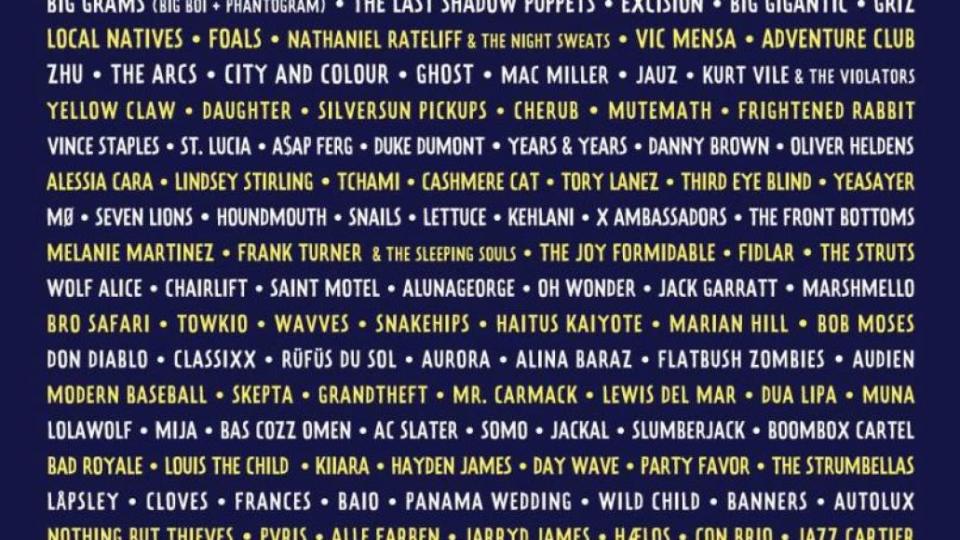
The Good: The expansion to a four-day schedule (a first for the festival) helped ease some of the scheduling conflicts in comparison to past editions. And although Lollapalooza is a globally known festival, its lineup boasted some quality homegrown talent, including Vic Mensa, Louis the Child, Flosstradamus, Towkio, and Joey Purp. (Also on the hip-hop front, Future — billed in the second line! — had bountiful options in his prolific discography for his set.) Headliners Radiohead and Red Hot Chili Peppers were both solid gets for top-tier bands who released new records that year, even if they both were hitting the festival circuit hard that summer. Same could have been said for LCD Soundsystem, who made a big splash with their huge slate of reunion festival gigs. Between The Last Shadow Puppets and The Arcs, Lollapalooza secured performances from two illustrious alumni: Alex Turner (Arctic Monkeys) and Dan Auerbach (The Black Keys), respectively. And elsewhere on the rock front, there was plenty of up-and-coming talent with great releases that year, from pop-punk/emo vanguards Modern Baseball to skate punks FIDLAR to roots rockers Pinegrove.
The Bad: History may view this lineup more favorably in the coming years, but at a glance bigger doesn’t necessarily mean better. While J. Cole is an undeniably good live performer, he’s the least intriguing of the headliners being nearly two years removed from his last studio album, 2014’s Forest Hills Drive. Similarly, a lot of the top-billed pop talent (Ellie Goulding, Lana Del Rey, G-Eazy) toured relentlessly in 2015. Kanye West played a pair of shows at the United Center solo later that ball, and getting ‘Ye to perform a festival gig in support of The Life of Pablo could’ve been a massive coup, especially as his GovBall set was canceled due to weather earlier in the summer.
Interesting Fact: Lollapalooza went all out for its 25th anniversary. Jane’s Addiction — fronted by festival founder Perry Farrell — performed at the festival for the first time in seven years. Over 1,500 artists reportedly asked to perform. Of the chosen few, Red Hot Chili Peppers headlined for a record-breaking fourth time.
–Killian Young
15. 1991
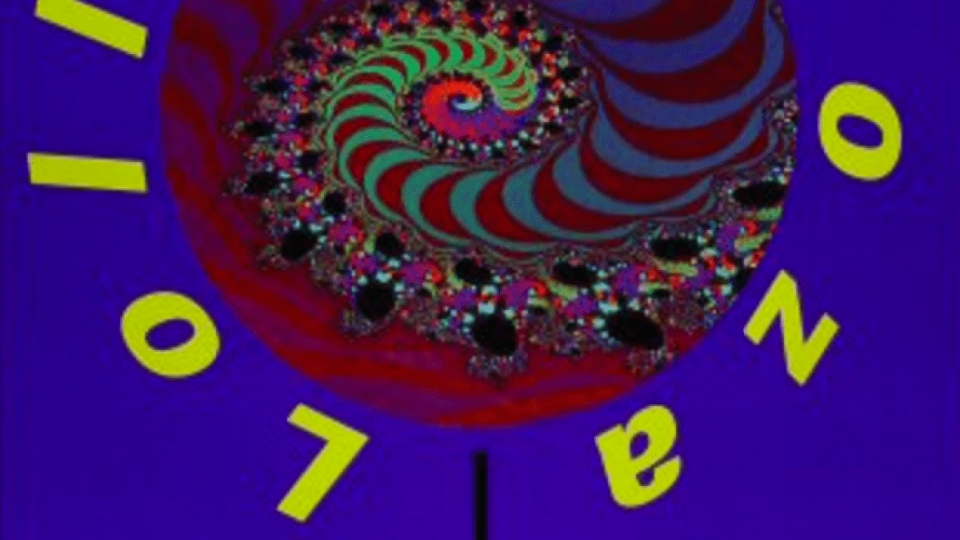
The Good: Lollapalooza was never intended to morph into the annual mega-festival that it ultimately became. It all started out, in fact, as a farewell tour for organizer Perry Farrell’s band Jane’s Addiction. “Putting together the first Lollapalooza was pretty easy,” the singer later recalled. “We just had fun putting together bands who we liked to perform with.” The bands that Farrell assembled were, at that time, the cream of the crop of the alternative scene. Artists like Nine Inch Nails, Butthole Surfers, and Rollins Band performed alongside a resurgent Ice-T and Living Colour, with Jane’s Addiction topping the bill. Even if it was a little more rag-tag than other similar events in Europe, the first iteration of Lolla was blissfully devoid of all the hoopla and corporate encroachment that marked the festival’s later years. A communal atmosphere hung heavy in the air as young fans moshed to songs like “Head Like a Hole” and “Mountain Song”. It established a different tone and aesthetic for the next generation of music fans and ultimately became a signature signpost of Perry’s so-called “Alternative Nation.”
The Bad: Because it was only intended as a one-off sort of deal, the selection of bands was pretty limited at the time, with most of the biggest cultural movers like Nirvana and Sonic Youth staying away. In an age where “curated festivals” have become the hot new trend, Lollapalooza in 1991 was the ultimate example, and while many enjoyed the music of Farrell’s Jane’s Addiction, others may have been less enthralled by the likes of Siouxsie and the Banshees, Fishbone, EBN, or Violent Femmes.
Interesting Fact: The word “Lollapalooza” itself dates back to the late 19th century and literally means “an extraordinary or unusual thing, person, or event; an exceptional example or instance.”
–Corbin Reiff
14. 1993
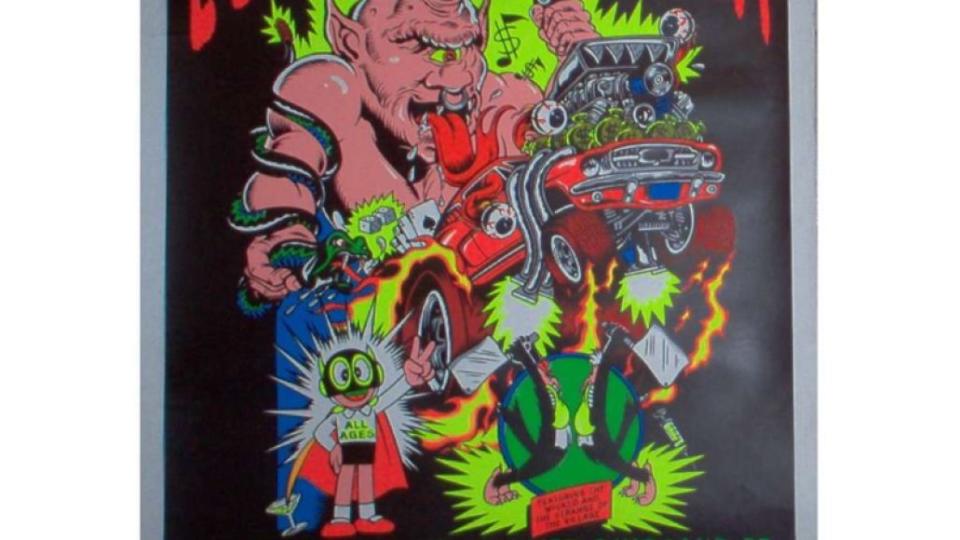
The Good: By 1993, alternative music was the talk of the industry due in no small part to the incredible success of Nirvana’s Nevermind and all the grunge groups that were carried into the major label system in its wake. While that meant a much higher profile for this now-annual tour, it also meant that Perry Farrell and his crew had another vast sea of acts to choose from. Gratefully, they avoided all the flavor-of-the-month bands that were cluttering up college radio and Alternative Nation episodes on the main stage with a lineup that was as sharp as ever. They managed to catch a pair of still-beloved acts — Primus and Alice in Chains — just as they were hitting their creative and commercial peaks, snapped up early hip-hop act Arrested Development right before their ignominious fall from grace, and peppered the main stage with an eclectic crew featuring industrial pop pioneers Front 242 and funk rockers Fishbone. The festival also saw one of its most infamous moments on this tour when Rage Against the Machine staged a protest at the Philadelphia stop, appearing naked on stage with tape over their mouths and the letters PMRC written on their chests. The crowd responded at first with approval, but soon showered the band with water bottles and jeers when they realized that RATM weren’t intending to play a lick of music.
The Bad: Though the main stage lineup proved that Farrell et. al. were paying attention to the diverse music being made by African-Americans, it was woefully lacking in female representation outside of noise rockers Babes in Toyland and a few members of Arrested Development’s crew. The side stage carried that flag instead with appearances by Free Kitten (featuring Sonic Youth member Kim Gordon), Tsunami, Unrest, Scrawl, and Luscious Jackson.
Interesting fact: Alice in Chains were actually intended to be the headliners for the festival, but when faced with the notion of following up the goofball prog-rock of Primus and deflating a potentially giddy crowd with their raw visions of addiction and mental anguish, they insisted upon the penultimate spot.
–Robert Ham
13. 2009
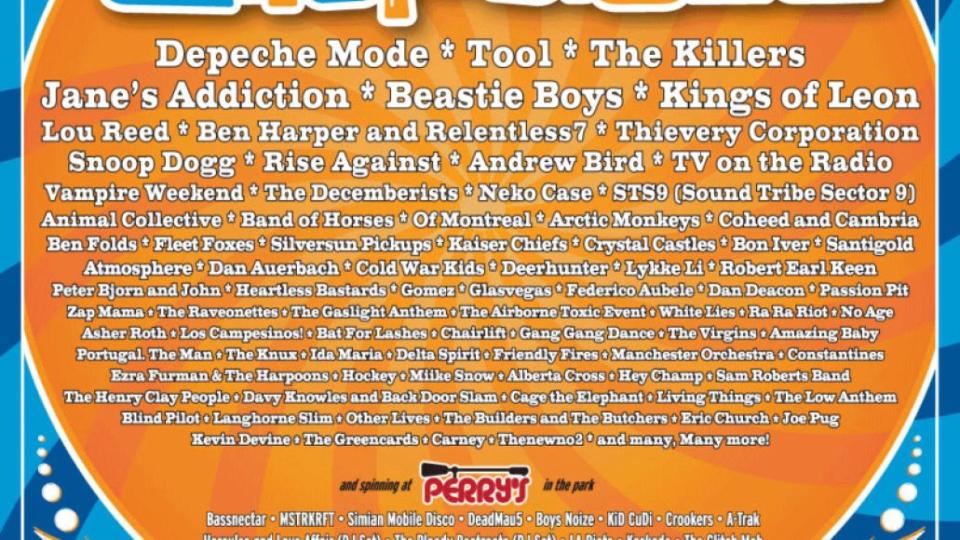
The Good: Lollapalooza landed Depeche Mode for their first (and only) US festival date of the summer in support of Sounds of the Universe, their first new record in over three years. And although Day & Age didn’t capture the same enormous success of Hot Fuss or Sam’s Town, The Killers were a safe bet for an entertaining set. Also the elusive Tool — still no closer to a new album today than they were back in 2009 — gave audiences an intense performance. Cage the Elephant broke through at Lollapalooza back in 2007 before they had even released their debut self-titled. But in 2009, Matt Shultz and co. announced themselves to the Lolla crowd in a big way, energetically tearing through early hits like “Ain’t No Rest for the Wicked” and “In One Ear”. The Louisville rockers weren’t the only great emerging talent to perform, though. The lineup also boasted a bunch of rising small-font talent, including the likes of Passion Pit, Manchester Orchestra, The Gaslight Anthem, Bat for Lashes, and Chairlift. Another act fans would remember most would be the late Lou Reed, who delivered a set that meandered through The Velvet Underground frontman’s long career. .
The Bad: Unfortunately, Beastie Boys had to cancel due to Adam Yauch undergoing cancer treatments. (They were admirably replaced by Yeah Yeah Yeahs.) Sure, Arctic Monkeys are way more popular in the UK — Humbug was their third No. 1 record across the pond — but their mid-level billing and late-afternoon set time seemed too low. History has also shown that among the top-billed artists, Kings of Leon had the least longevity. While Only by the Night was an undeniable commercial success led by hits “Sex on Fire” and “Use Somebody”, their discography still doesn’t seem robust enough to justify a headlining spot.
Interesting Fact: Over at the child-friendly Kidzapalooza, nine-year-old guitar prodigy Yuto Miyazawa dazzled with impressive covers of Jimi Hendrix’s “Purple Haze”, Ozzy Osbourne’s “Crazy Train”, and more.
–Killian Young
12. 1996
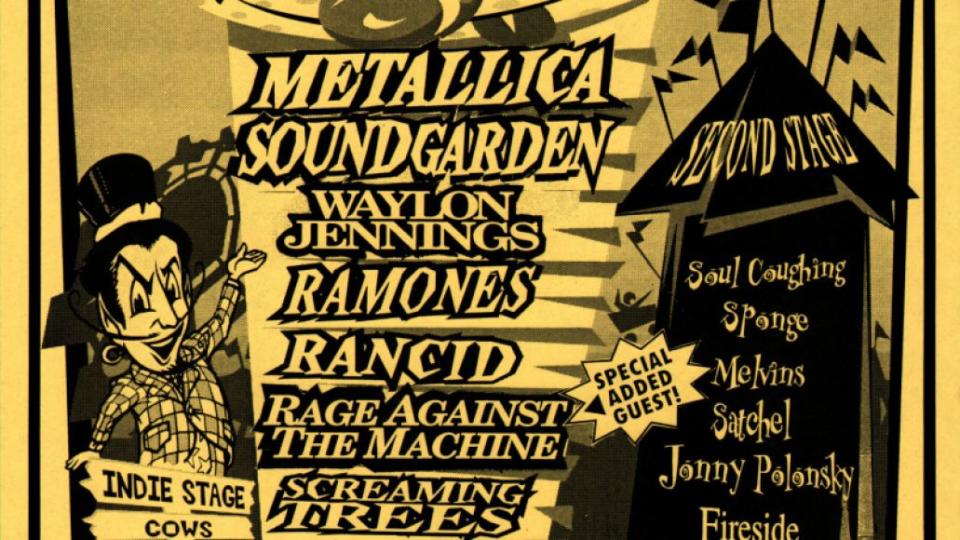
The Good: Give the organizers of Lollapalooza a little credit for trying to keep things interesting. Smarting from the loss of founder Perry Farrell (who left to focus on electronic music-themed ENIT Festival), they shot for the moon a bit, banking on the crossover success of Metallica who served as the touring event’s headliner in 1996 and backed them up with a main stage lineup that leaned heavy without veering into nü rock territory with acts like Soundgarden, Screaming Trees, and Ramones. They also wisely listened to the requests and eclectic tastes of their headliner when booking other acts for the 25-city tour. That meant some surprising choices like Cocteau Twins, Waylon Jennings, Cheap Trick, and Steve Earle. As always, things were even more interesting on the smaller stages where an array of indie acts including Ben Folds Five, Cornershop, Moonshake, Melvins, and The Cows held court.
The Bad: Perry Farrell derided the 1996 lineup as being “too macho” and for good reason. The folks who attended the 1996 version were likely first-time Lollapaloozans there to bathe in the hard-and-heavy glory of the metal and metal-adjacent sounds. That meant that the pop, hip-hop, and country acts on the bill throughout the summer got nearly no notice from the huddled masses or worse as when Cocteau Twins were pelted with mud by grumpy attendees during the fest’s opening day in Kansas City after some technical problems caused a delay in their set.
Interesting Fact: This was the first time that a main stage act from a previous Lollapalooza returned to play the fest again with Soundgarden performing for the full run of dates and 1993 alum Rage Against the Machine appearing on a few stops of the tour.
–Robert Ham
11. 2023
The Good: There’s a lot to love about the 2023 edition from a global standpoint — a returning headlining performance from K-Pop rising stars Tomorrow x Together, as well as a headlining set from Latin superstar Karol G, cements the 2023 festival as Lollapalooza’s most culturally diverse lineup yet. But even deeper in the lineup are dozens of up-and-coming favorites, from viral stars like Hemlocke Springs, Neil Frances, and The Linda Lindas to more traditional festival mainstays, like Foals, Pusha T, beabadoobee, and Carly Rae Jepsen. There’s less of a “skew” genre-wise in 2023, with hip-hop taking a slight backseat to more hybrid, genreless artists like Jean Dawson, Brakence, and Sueco. But there’s something for everyone, especially if you’re attending with the headliners in mind: Kendrick Lamar is always welcome as a festival headliner, Red Hot Chili Peppers are still a blast live, and Billie Eilish is only becoming a bigger rarity as her career continues to skyrocket. Add in great electronic sets from The Knocks, Fred again.., and Louis the Child, and you’ve got a Lollapalooza to remember.
The Bad: There’s a fair amount of bland artists selected for 2023 — Yung Gravy certainly doesn’t have much more to offer beyond his snooze of a hit, “Betty (Get Money),” and Perry’s Stage EDM heavyweights Afrojack, Svdden Death, and Alan Walker are generally run-of-the-mill artists who are, arguably, past their prime. Furthermore, the lineup does seem to lack some rarity and excitement. Lana Del Rey and Billie Eilish may not be slated to play every festival as they have in year’s past, but Lollapalooza often manages to snag one or two names that feel timely and unique, and those two artists only scratch the surface. It’s still an impressive lineup that sheds light on the festival’s optimistic, genreless future, but for the moment, Lollapalooza is still in the midst of a major identity transformation, and this lineup echoes that.
Interesting Fact: Karol G will make history at Lollapalooza in 2023, becoming the first Latin headliner in the history of the festival.
— P. Ragusa
10. 2013
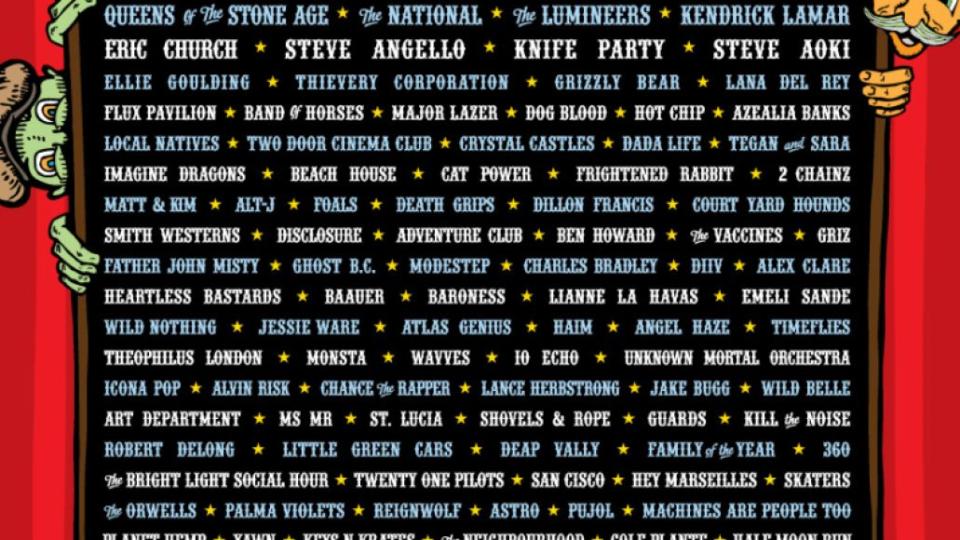
The Good: Regardless of what you think of Mumford & Sons, a massive festival like Lollapalooza is what the British folk-rockers are built to excel at. After also performing in 2010, Marcus Mumford and co. triumphantly returned to headline after the massive success of Babel. The top of the bill also featured fellow crowd-pleaser The Killers and The Cure, known historically for their unique, extensive setlists. Also taking a top spot were Nine Inch Nails, with Trent Reznor and co. resurrecting the band from its previous hiatus to support Hesitation Marks. The festival also nabbed critical darlings Vampire Weekend at the perfect time, as they toured the recently released Modern Vampires of the City. On the hip-hop front, two burgeoning rap stars were riding high after groundbreaking releases: Chicago native Chance the Rapper released Acid Rap, while Kendrick Lamar grew into a headlining-caliber performer after the massive success of good kid, m.A.A.d city. Smaller-font acts would gain greater traction on more recent album cycles, including Father John Misty, Foals, and HAIM. Lollapalooza (and its after-show) was also the site of the final shows for The Postal Service.
The Bad: The mercurial Death Grips were slated for an after-show and a Lolla set, but notoriously failed to even show up to Chicago, which led to some pretty angry fans trashing Bottom Lounge. Similarly, controversial emcee Azealia Banks dropped out “due to a severe throat infection.” Because of the dense schedule, conflicts abounded. Perhaps the most difficult choice for music fans was deciding between four worthy overlapping sets on Friday: Queens of the Stone Age, Disclosure, Chance the Rapper, and New Order. As far as what could have been, some of the more unique legacy gets for Lolla’s competitors would’ve all been welcome additions: Paul McCartney (Bonnaroo), Blur, or The Stone Roses (both on Coachella).
Interesting Fact: Nine Inch Nails’ Live 2013 EP included “Came Back Haunted”, “Sanctified”, and “Find My Way”, all of which were recorded during Lolla.
–Killian Young
09. 1995
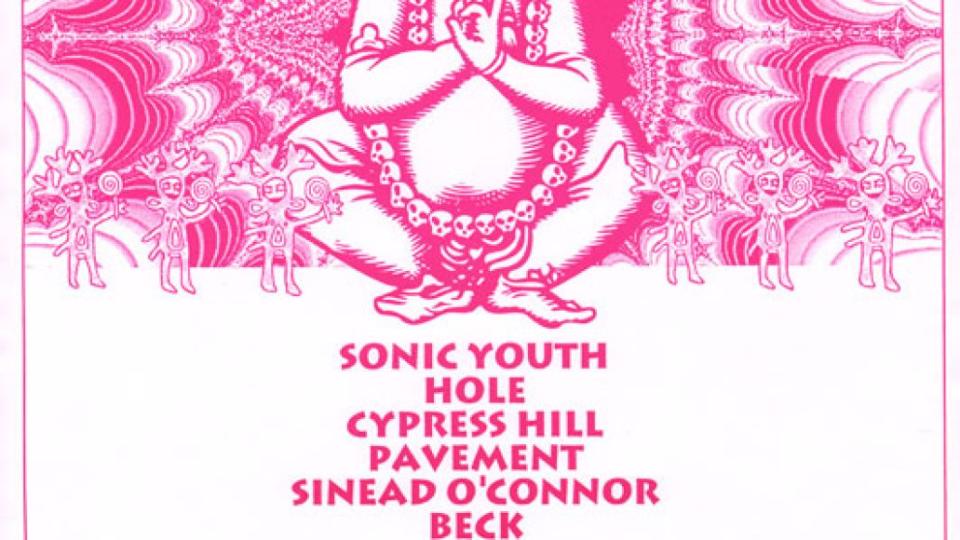
The Good: Things got interesting in 1995, a controversial turning point for the festival. As The Washington Post put it, “Lollapalooza ’95 would mark alt-rock’s peak, and the beginning of its decline.” Who knew a festival had so much power. By this point, Lollapalooza had become a household and reliable brand name, making it easier to take risks in terms of lineup. This year featured impressive headliners like Hole, fronted by the recently widowed Courtney Love, Sonic Youth, Sinead O’Connor, Jesus Lizard, Beck (who the New York Times labeled a “newcomer” at the time), Cypress Hill, and Pavement.
The Bad: Pavement’s set featured a mud fight that was fun for fans but left the band feeling bitter. Once frontman Stephen Malkmus was hit in the chest with a heap of mud, the band promptly walked off stage — though not before Scott Kannberg flipped off the crowd and then tastefully, and maturely, mooned them all. To make matters worse, this year saw a shift from open fields to smaller, fixed-seat amphitheaters, which bands disliked due to the rows of empty seats that placed an uncomfortable distance between them and their fans that remained on the lawn.
Interesting Fact: Pavement was actually supposed to headline the previous year alongside The Smashing Pumpkins, but Billy Corgan dramatically stated if Pavement were on the lineup, he would back out of headlining. And what Billy wants, Billy gets.
–Lyndsey Havens
08. 2015
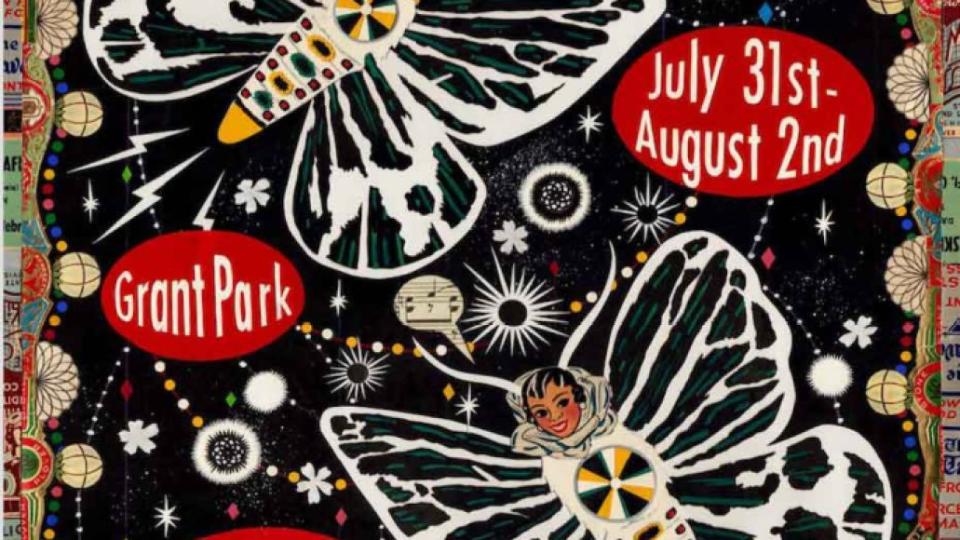
The Good: 2015 was the year of Sir Paul. Securing McCartney as a headliner proved Lollapalooza could still reign in top-tier talent, even if it means they often have to follow in the shadows of Bonnaroo (where the former Beatle headlined two years prior). He wasn’t the only veteran headlining act, though, as Metallica nearly packed the south end of the park past capacity when they performed. The lineup was further strengthened by Florence and the Machine, whose enchanting and electrifying set was cut short due to lightning and an impending storm, and The Weeknd, who was fresh off his remarkable debut, which had established him as a prime-time artist. The earlier sets included notable performances from Tame Impala, Gary Clark Jr., TV on the Radio, Alabama Shakes, and twenty one pilots, who brought their fusion of nearly every genre to the stage for what was one of the weekend’s most compelling and energetic performances.
The Bad: By this point in Lollapalooza’s long-running history, an evacuation has nearly become a staple. The third and final day of the festival brought intense storms that required the park to be evacuated for 90 minutes. While no performances were cancelled — mid-afternoon sets were just shortened — C3 briefly had plans of extending the evening by 30 minutes, though that fell through once storms moved in again. Aside from the uncontrollable weather, hip-hop artist Travis Scott was arrested following his set, in which he encouraged fans to jump the barricade separating them from Perry’s stage. Another downfall of Perry’s was that the booming bass bled into McCartney’s set, which he acknowledged by saying, “I planned this. It’s like a mashup between me and whatever shit they’re playing.”
Interesting Fact: In 2015, Lollapalooza added Berlin to its growing list of locations. The festival’s first year featured Macklemore & Ryan Lewis, Muse, and Sam Smith among others.
–Lyndsey Havens
07. 2006
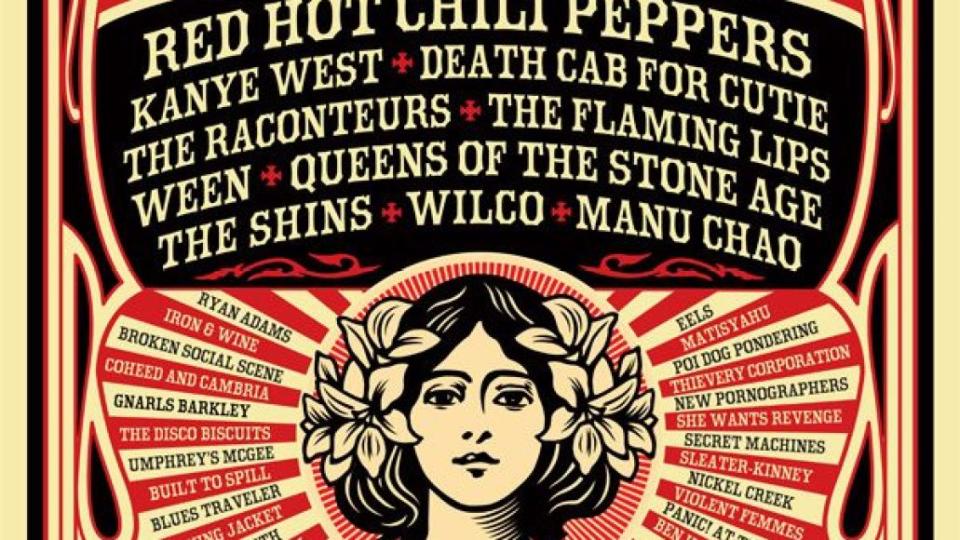
The Good: A decade later, if you were to have this exact same lineup, there are eight artists you could feel great about billing as a headliner: Kanye West, Red Hot Chili Peppers, Queens of the Stone Age, The Flaming Lips, Sonic Youth, Sleater-Kinney, 30 Seconds to Mars, and Jack White (then with The Raconteurs). Nowadays, a varied lineup of rock, pop, hip-hop, and electronic at Lollapalooza is a given, but 2006 is when that diversity really began to take hold. Sure, some hip-hop acts had played the fest in the past (A Tribe Called Quest, Ice Cube, Cypress Hill, etc.), but landing a bona fide superstar like ‘Ye was on another level. (West was fresh off three Grammy wins and was also joined on the lineup by fellow hometown hero Common.) At the time, this was also Sleater-Kinney’s final festival performance before their lengthy hiatus, which had been announced just over a month before. Also, a solid subset of the small-font acts were primed for later success: Panic! At the Disco were already main stage-ready after their strong debut, A Fever You Can’t Sweat Out; My Morning Jacket’s Z was their most successful record to date; and Death Cab for Cutie’s major-label debut, Plans, would go platinum. After reuniting earlier the previous winter, Smoking Popes also gave Chicago a rollicking hometown show.
The Bad: Lollapalooza purists might argue that this edition represented a turning point when the event started to become generic, a corporate cash grab that strayed from its rock ‘n’ roll roots (but the merits of that are debateable). As is the case with any major festival, some of the year’s most popular talent would prove to be a flash in the pan, like Gnarls Barkley riding high on “Crazy” or Matisyahu, who was buoyed by his biggest hit, “King Without a Crown”.
Interesting Fact: This was the first year that Lollapalooza expanded to its three-day format, which paid major dividends: Average daily attendance increased over 80 percent in comparison to the prior year.
–Killian Young
06. 2010
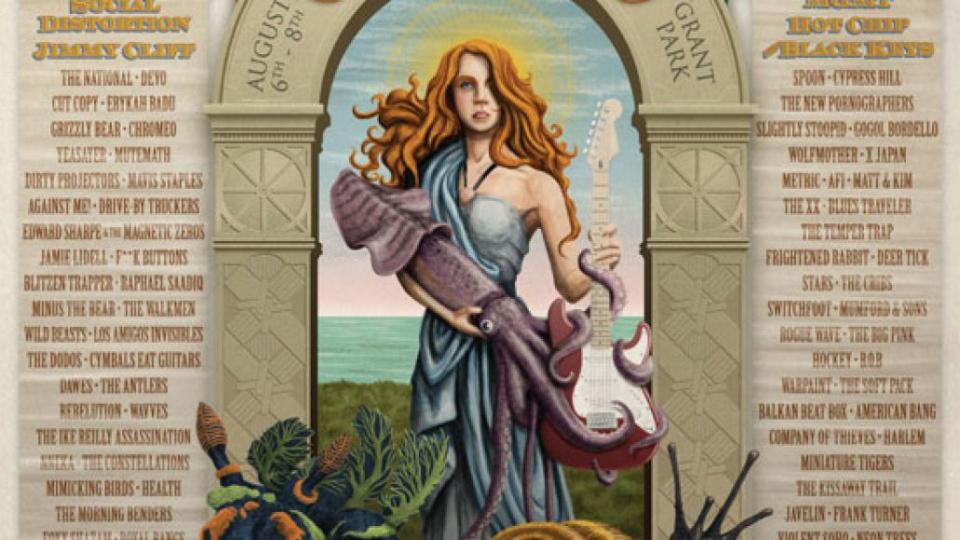
The Good: When it was first established in 1991, Lollapalooza was primarily conceived as a showcase for rock music. Rarely has the festival embraced that concept as fully as it did in 2010. The lineup that year was overflowing from top to bottom with some of the most pivotal and impressive indie, alternative, and punk rock acts that have ever graced a stage. In the headliner’s slot, you had a newly reformed Soundgarden and Green Day; then in smaller font just below, there was Arcade Fire, The Strokes, The Black Keys, The National, Wolfmother, MGMT, and The New Pornographers. Those first four names could easily headline almost any festival in the world at this point. And that’s not even mentioning Lady Gaga, Devo, Spoon, Cypress Hill, Erykah Badu, Mavis Staples, or the Drive-By Truckers. The term “stacked” barely begins to do the 2010 lineup any real justice.
The Bad: This is less about Lolla itself than the impact the festival has on the Chicago area music scene. In 2010, it came to light that the festival imposes a radius clause in the contracts with many of the acts it hires to perform. Essentially, if you hit a Lolla stage, you can’t perform anywhere near the city of Chicago at any point for as long as six months prior and three months after the festival takes place — and that can include venues as far as 300 miles away. The radius clause has been a major black eye for Lolla, especially after an investigation was launched into the practice by the Illinois State Attorney General’s Office; however, little has been done to curb its use.
Interesting Fact: 2010 marked the first year that the Lollapalooza brand expanded beyond the confines of North America, hosting a two-day festival just outside of Santiago, Chile. In the years to follow, the Lolla banner would move throughout South America with similar events staged in Brazil and Argentina.
Attendance: 240,000
–Corbin Reiff
05. 2007
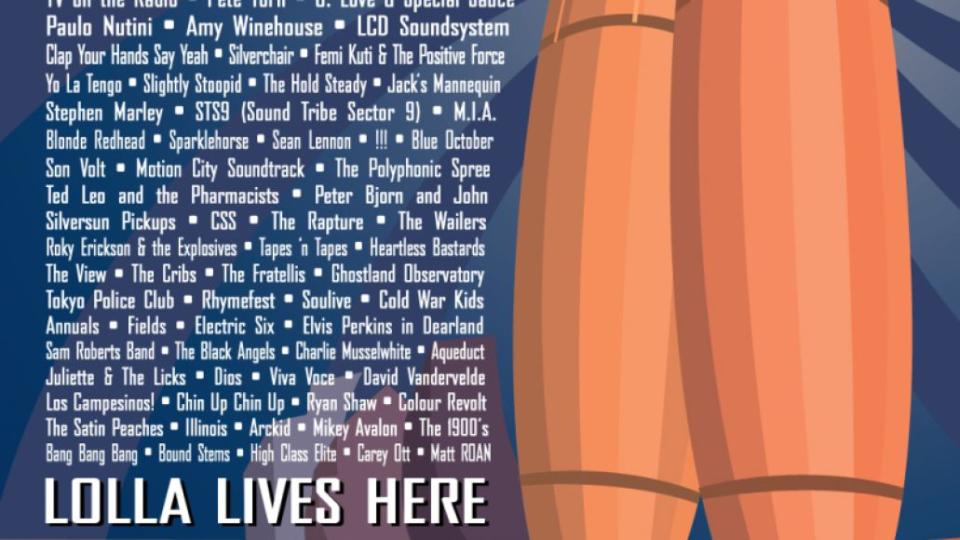
The Good: If you were lucky enough to be at the 2007 edition of Lollapalooza, you might be able to have the kind of bragging rights that all music fans hope for when they attend events of this kind. Because this installment boasted a pair of sets by two female artists on the rise to megastardom and infamy. The biggest “you wish you were there” moment was the late afternoon set by Lady Gaga. Appearing with her former performance artist partner Lady Starlight, and clad in a mirror ball-inspired bra and thigh-high stockings, she cut a figure as striking as the disco pop she performed that presaged her multi-platinum success just one year later. The festival also brought a great deal of attention to Amy Winehouse, whose album Back to Black was just then starting to catch fire among the music tastemakers of the world. By all accounts, her set was a masterful one, showcasing her rough-and-ready vocals and the slinky throwback soul of her backing band. If that weren’t enough to mark this as a Lollapalooza for the ages, just check out the other headliners for the weekend: Daft Punk, Muse, LCD Soundsystem, and Pearl Jam. And give respect to the festival’s attempts to embrace international artists on a big scale by welcoming in Cafe Tacuba, Femi Kuti, and Stephen Marley.
The Bad: It speaks to Perry Farrell’s ego and general hubris that he would be bold enough to throw his band Satellite Party onto the lineup. Worse still was his decision to place his lukewarm group second-to-last on the opening night of the festival, right before Daft Punk. Bit of a rude awakening for anyone trying to get a prime spot to bathe in robot disco glory.
Interesting Fact: The KIDZ Stage has been a go-to destination for a lot of hip parents who drag their young ones to Grant Park for the weekend. This time, though, they were rewarded by sets from Mekons-adjacent outfit the Wee Hairy Beasties and icons like Patti Smith and Jim James.
–Robert Ham
04. 1992
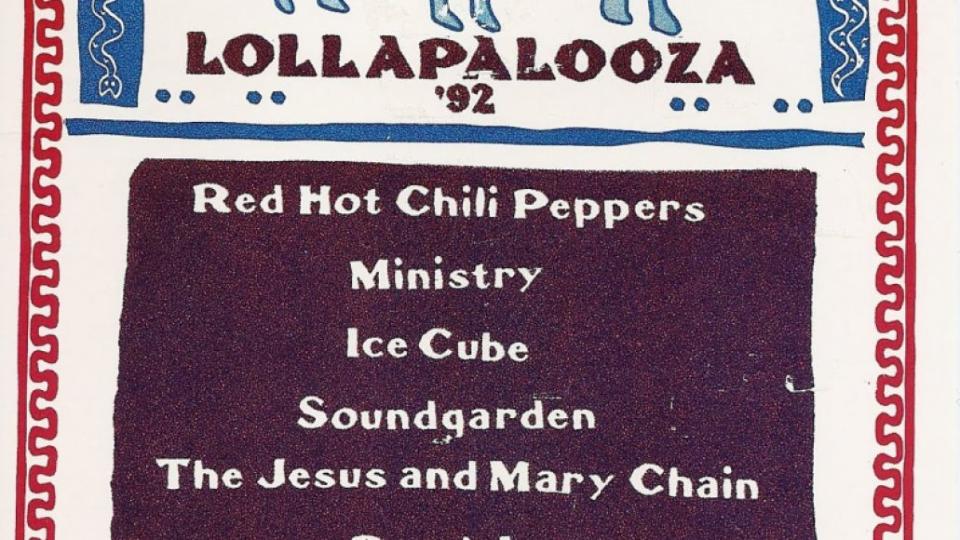
The Good: 1992 was the year that Lollapalooza really came into its own. A second stage was added to the touring festival, and Farrell and the other organizers called in some real heavy hitters to join them out on the road. Grunge and alt rock clearly dominated the lineup with the Red Hot Chili Peppers, Soundgarden, and Pearl Jam all taking over the main stage while Rage Against the Machine, Stone Temple Pilots, and Temple of the Dog held it down throughout the day on the smaller side stage. And yet for as heavily as the guitars shredded, there was also an impressive dose of rap and hip-hop to be found in the guise of Ice Cube, Cypress Hill, House of Pain, and first year holdover Ice-T. Most of the artists featured were all at, or approaching the peak of, their creative prowess and cultural relevancy, and more than any other iteration of the festival, the 1992 run really captured the feeling of Farrell’s so-called Alternative Nation. Alongside Nirvana’s showing that year at the Reading Festival in the UK, this summer run might just be the peak musical moment of Generation X.
The Bad: Being that it was still a mostly independent-run event, the lineup was fleshed out by a number of acts that time has really forgotten. While the mainstage managed to put out a consistently high level of talent, the side stage was awash with artists like The Vulgar Boatmen, Skrew, Sometime Sweet Susan, and Ivan Krall to name just a few.
Interesting Fact: Jim Rose’s Circus Side Show act joined up with the tour and regaled audiences nationwide with an eclectic arrangement of old-school carnival acts like a man who drove a nail through his nostril. The entire thing would later be parodied by The Simpsons in an episode in the show’s seventh season when Homer joined up with the fictional festival Hullabalooza as a guy who gets shot in the stomach with a canon.
–Corbin Reiff
03. 2012
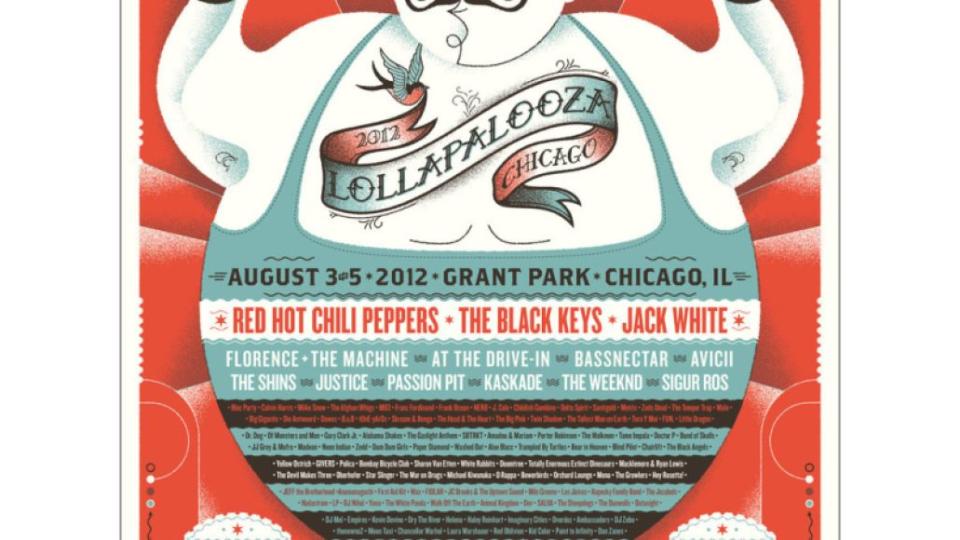
The Good: 2012 boasted one of the most stacked and diverse lineups of the festival’s recent, Chicago-based history. When you place Sigur Ros third to last behind a reunited At the Drive In and a headlining set by Jack White, it would have to be, right? Weather concerns notwithstanding (see below), the festival stayed true to its original roots by pulling in a legacy rock act like Black Sabbath; superstars such as Red Hot Chili Peppers (still riding high on the success of I’m with You), The Weeknd, and Avicii; and plenty of soon-to-be headliners ranging from Macklemore & Ryan Lewis and Fun. to Tame Impala and The War on Drugs. The real story, though, was the triumphal set by Frank Ocean. He had released his album channel ORANGE just a month before but that record had already signaled a seismic shift in rap and R&B that has been expanded upon to greater commercial heights by the likes of Drake and Future. But for one glorious Saturday night in Chicago, all eyes were on Ocean, and he responded beautifully with a set that opened with hushed acoustic numbers and finished with a earth-shaking rendition of “Pyramids” with stops in between for heartfelt pleas of peace, sex, and romance.
The Bad: 2012 was also the first year that the weather in Chicago wreaked havoc on the event. On Saturday August 4th, the threat of huge thunderstorms prompted a then-unheard-of full evacuation of Grant Park and caused several sets by acts like Alabama Shakes, Neon Indian, B.o.B., and The Temper Trap to either be cut short or canceled completely. Gratefully, nothing terrible happened, but it did put a bit of a damper on the day for many festivalgoers.
Interesting Fact: Mayor Rahm Emanuel allowed Lollapalooza to go past its 10 p.m. curfew on Saturday because of the rain delay but gave no quarter the next night. That led to moments like local DJ Kaskade having his set unceremoniously halted right in the middle of his final song of the night.
–Robert Ham
02. 1994
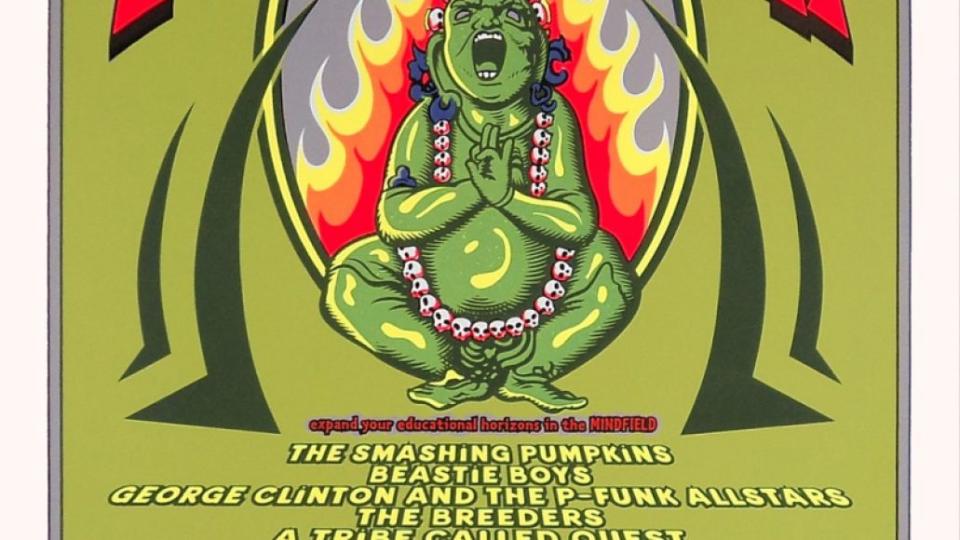
The Good: This was Lollapalooza’s best year in the ’90s, with three prior years’ experience building up to the touring festival’s juggernaut of an alt rock lineup. So many of its main stage artists were at or near their peak: The Smashing Pumpkins post-Siamese Dream, Beastie Boys with their chart-topping Ill Communication, and Green Day, who had just gotten their first major taste of success with Dookie (to name just a few). For early Lollapalooza, this lineup also had a healthy helping of hip-hop, from side stage act Cypress Hill (who had skyrocketed to their first No. 1 album with Black Sunday) to A Tribe Called Quest (who had just released their excellent Midnight Marauders the previous winter). George Clinton & the P-Funk All Stars remains one of the most unique gets in Lolla history in terms of truly iconic old-school acts. On the side stage, The Flaming Lips were bound for a prolific, zany career led by charismatic lead singer Wayne Coyne. And despite the turmoil of the rock world after Kurt Cobain’s suicide earlier in the year, Courtney Love made surprise appearances on the festival to perform in memory of the Nirvana singer.
The Bad: Most notably, Nirvana was originally supposed to headline as well, but the band canceled mere days before Kurt Cobain’s body was tragically found. Out of the main stage acts, the one that historically looks most out of place are Boredoms, the eclectic experimental Japanese band who opened on the main stage for part of the tour. On the second stage, understandably some of the billed bands fizzled quickly by the turn of the millennium, like Rollerskate Skinny and King Kong, but overall there are very few complaints about this lineup.
Interesting Fact: A side attraction of the festival was the “Electric Carnival”, which featured (among other things) Internet connection! The flyer features many incredible phrases from the Digital Revolution, including: “Step inside and check out the Internet, a sprawling anarchic spider web of computers connecting people with each other and sharing information.”
–Killian Young
01. 2008
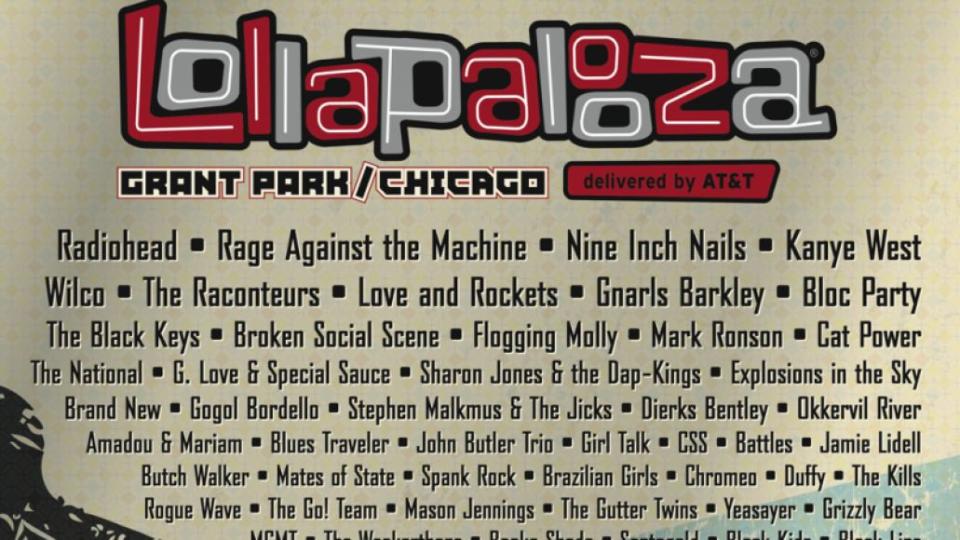
The Good: While Radiohead returned to Lollapalooza last year in light of their standout A Moon Shaped Pool, they earned their first headlining slot at the festival in 2008 following the success of their groundbreaking “pay what you want” release, In Rainbows. The album went on to win the Grammy for Best Alternative Music Album and topped several “best of” lists, making the indie icons idyllic headliner material, which they remain to this day. And on a final Radiohead note, let’s not forget that fireworks just so happened to erupt behind the band (not planned by the festival) as they dove into “Fake Plastic Trees”. Okay, I lied. The final Radiohead factoid is that nobody was scheduled to play against them, which says a lot — now, moving on.
Other big-name performers who are making headlines as of late included Kanye West, Brand New, and Wilco. The lasting relevancy of these acts and others prove what a tastefully curated lineup 2008 really was. Additionally, a handful of acts that are now on hiatus, or have recently resurfaced, also made this lineup one to remember, with sets from The Raconteurs, Lupe Fiasco (who just returned with a new single), Nine Inch Nails (who may be returning soon), and Rage Against the Machine, whose high-energy set resulted in mosh pits so intense that fans were actually being tossed over the barricade separating the stage from the crowd.
The Bad: Rage Against the Machine’s epic set also became one of the weekend’s downfalls, as it grew so volatile that frontman Zack de la Rocha had to stop the performance three times due to the dangerous conditions, and at one point Lollapalooza’s head of security even made a brief appearance on stage to consult the band. And in other less than fortunate news, 2008 also marked the year of no return — the debut of the electronic dance music stage, Perry’s.
Interesting Fact: Following the success of this year’s festival, a new deal was signed to keep Lollapalooza in Chicago though 2018.
–Lyndsey Havens
A Definitive Ranking of Every Lollapalooza Lineup from Worst to Best
Consequence Staff
Popular Posts
Morrissey Rips Sinead O'Connor Tributes: "You Hadn't the Guts to Support Her When She Was Alive"
Tina Fey in Talks to Take Over Saturday Night Live from Lorne Michaels: Report
The Worst Person You Know (Morrissey) Just Made a Great Point
10 Essential Sinéad O'Connor Songs That Aren’t “Nothing Compares 2 U”
